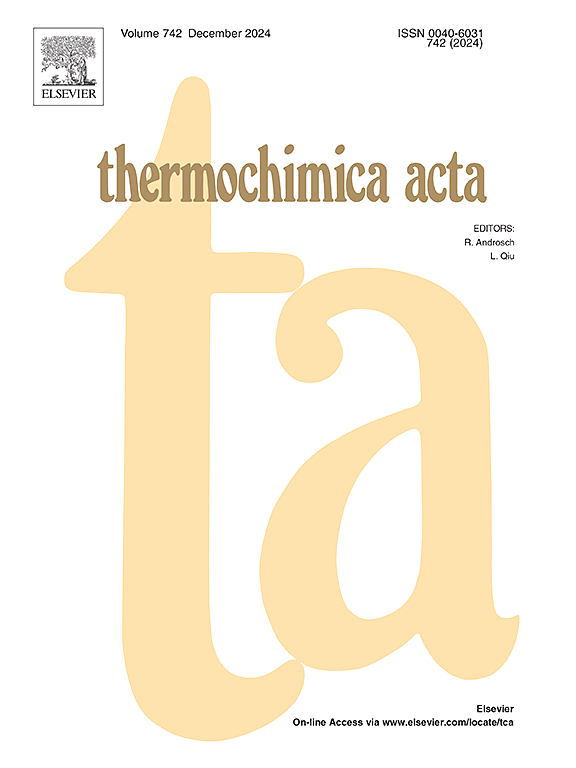Study of Heavy Oil In-situ Combustion with Copper Biocatalysts: Kinetics and Thermodynamic Aspects of High-Temperature Oxidation Reactions
IF 3.1
2区 化学
Q2 CHEMISTRY, ANALYTICAL
引用次数: 0
Abstract
In-situ combustion is considered an efficient thermally enhanced oil recovery method. However, the combustion front stabilization remains a challenge for the scientific community. The present study examines the efficacy of copper tall oil (Cu-TO) and copper sunflower oil (Cu-SFO) on heavy oil high-temperature oxidation reactions, which are believed to solve this challenge. We applied non-isothermal differential scanning calorimetry (DSC) analyses combined with an isoconversional kinetic approach in order to calculate kinetic parameters, thermodynamic functions, and the effective rate constant of these reactions. The obtained results demonstrated that both catalysts are able to reduce the activation energies and shift oxidation regions to lower temperatures, with Cu-SFO showing superior performance. Kinetic predictions further supported these findings and revealed that the selected catalysts contributed significantly to decreasing oxidation times across all conversion ranges. Additionally, thermodynamic analyses indicated that Cu-SFO facilitated a more ordered and energetically favorable oxidation process, as demonstrated by increasingly negative entropy values and consistently lower Gibbs free energy. The research highlights the Cu-SFO catalyst exceptional ability to accelerate the transition from low-temperature to high-temperature oxidation while maintaining high catalytic activity. Taken together all these results, this research work contributes to provide comprehensive insights from the kinetic and thermodynamic analysis that reveal unique catalytic effects and reaction mechanisms, presenting an approach to stabilize combustion front and improve heavy oil recovery efficiency, addressing a critical challenge in the field of in-situ combustion.
利用铜生物催化剂研究重油原位燃烧:高温氧化反应的动力学和热力学问题
原地燃烧被认为是一种高效的热力强化采油方法。然而,燃烧前沿的稳定仍然是科学界面临的一项挑战。本研究探讨了铜妥尔油(Cu-TO)和铜葵花籽油(Cu-SFO)对重油高温氧化反应的功效,相信它们能解决这一难题。我们采用非等温差示扫描量热法(DSC)分析,结合等转化动力学方法,计算了这些反应的动力学参数、热力学函数和有效速率常数。结果表明,这两种催化剂都能降低活化能,并将氧化区转移到较低的温度,其中 Cu-SFO 的性能更优。动力学预测进一步支持了这些发现,并表明所选催化剂在所有转化范围内都能显著缩短氧化时间。此外,热力学分析表明,Cu-SFO 促进了更有序、能量更有利的氧化过程,这表现在熵值越来越负,吉布斯自由能越来越低。这项研究凸显了 Cu-SFO 催化剂在保持高催化活性的同时加速从低温氧化向高温氧化过渡的卓越能力。综合所有这些结果,这项研究工作有助于从动力学和热力学分析中提供全面的见解,揭示独特的催化效应和反应机理,提出了一种稳定燃烧前沿和提高重油采收效率的方法,解决了原位燃烧领域的一个关键挑战。
本文章由计算机程序翻译,如有差异,请以英文原文为准。
求助全文
约1分钟内获得全文
求助全文
来源期刊

Thermochimica Acta
化学-分析化学
CiteScore
6.50
自引率
8.60%
发文量
210
审稿时长
40 days
期刊介绍:
Thermochimica Acta publishes original research contributions covering all aspects of thermoanalytical and calorimetric methods and their application to experimental chemistry, physics, biology and engineering. The journal aims to span the whole range from fundamental research to practical application.
The journal focuses on the research that advances physical and analytical science of thermal phenomena. Therefore, the manuscripts are expected to provide important insights into the thermal phenomena studied or to propose significant improvements of analytical or computational techniques employed in thermal studies. Manuscripts that report the results of routine thermal measurements are not suitable for publication in Thermochimica Acta.
The journal particularly welcomes papers from newly emerging areas as well as from the traditional strength areas:
- New and improved instrumentation and methods
- Thermal properties and behavior of materials
- Kinetics of thermally stimulated processes
 求助内容:
求助内容: 应助结果提醒方式:
应助结果提醒方式:


